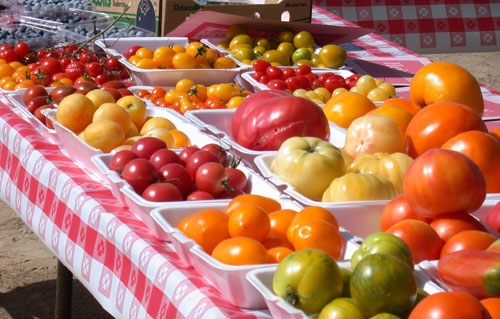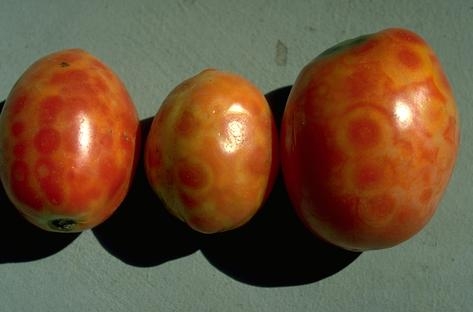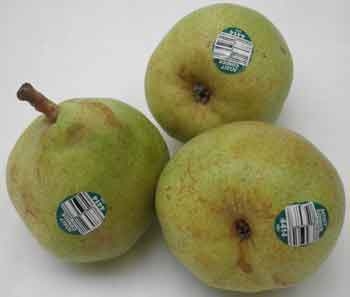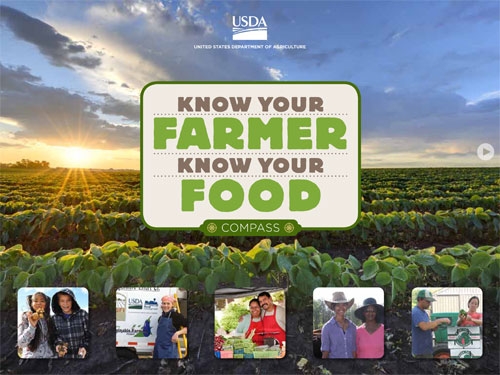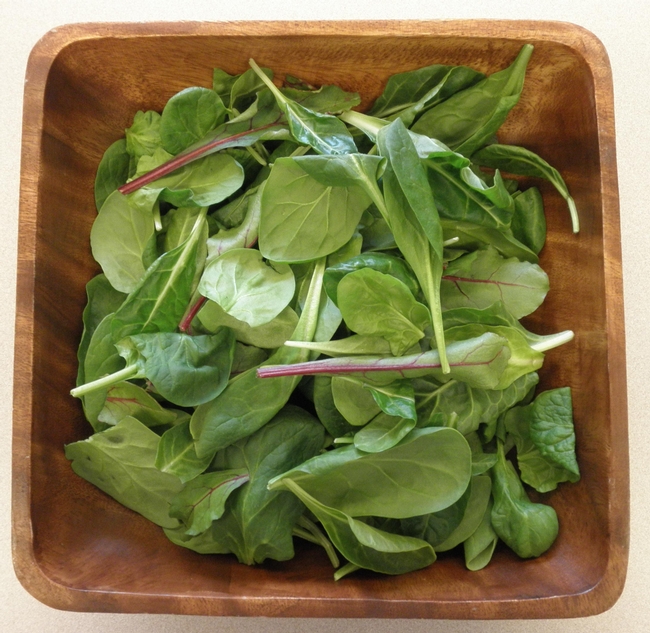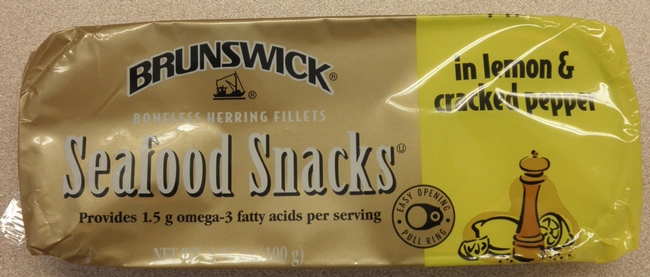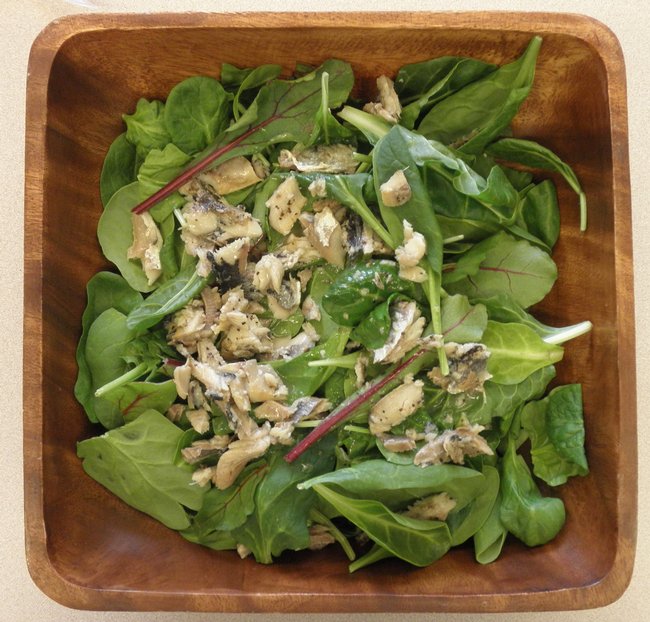UC Food Blog
Tomatoes for flavor, for food and for everyone
Tomatoes are the No. 1 garden crop in America. Everyone who has a summer garden grow tomatoes. There are more blogs, forums, tweets, and garden club and café talks about tomatoes than any other garden vegetable. Tomatoes are used in so many recipes, and can be preserved so easily into so many products it just makes sense to grow them in your garden. The garden lore about growing tomatoes successfully abounds. And the really good new . . . the failure rate for tomatoes is pretty darn low. You may not get as many as you like but you will get some pretty much guaranteed even with the low yielding heirloom varieties.
The really hard part about growing tomatoes is trying to select the variety for your location, the preferred size of your tomato fruit whether it is a small, medium or large, a paste or slicing type, red or yellow or orange or striped, or to select for plant size and growth habit, such as suitable for containers or should make the priority disease resistance? Or should you just choose whatever the nursery has in stock?
The first consideration for variety selection should be climate. There are three basic tomato growing zones in California. Zone A is the coastal area of Santa Barbara south; it includes the coastal foothills, and mountain ranges from San Diego though Marin Counties and the foothills surrounding the Central Valley, Napa and Sonoma Valleys. These areas are typified by summer daytime temperatures are warm but below 95F. Zone B are the inland valleys and high and low deserts. This area has daytime temperatures that regularly exceed 95F. Zone C are the intermediate central and northern coastal areas; cool coastal valleys from Santa Maria north to the Oregon border and include the SF Peninsula. These areas have cool to moderate summers with evening temperatures in the 45-55F. While many varieties have been evaluated for their climatic adaptations, many have not so keep that in mind when selecting your varieties. Examples of each are in the table below.
|
Zone A |
Zone B |
Zone C |
Not yet evaluated |
|
Sungold Cherry |
Sungold Cherry |
Sungold Cherry |
Brandywine |
|
Ace |
Ace |
Carmelo |
Beefmaster |
|
Better Boy |
Bush Champion determinant |
Patio Hybrid |
Lemon boy |
|
Floramerica Hybrid VFFNASt |
Floramerica Hybrid VFFNASt |
Bingo VFT |
Roma |
|
Supersteak |
Early Pick Hybrid |
Champion Hybrid VFNT |
Goliath Hybrid |
|
Early Girl Hybrid VFF |
Shady Lady |
Dona |
Green Zebra |
|
Jackpot Hybrid |
Early Bush 76 VF |
Stupice |
Green Grape |
|
Whopper Improved |
Celebrity |
Legend |
|
Next is to decide how big you want your plants to grow. Determinant or “bush” varieties are those that grow to a given size (about 3-5 ft) and bear most of their fruit within about 4-6 weeks. If you like to can your produce, a determinate variety would be best since you harvest most all the fruit in a narrow window.
Indeterminate tomato varieties grow and set fruit all summer until they are killed by the frost. This type is good if you have the room to stake or trellis them and want a continual harvest. I like to plant some of each.
The last thing to evaluate in selecting varieties is disease resistance. One disease that really has become a problem in many gardens is tomato spotted wilt virus. (see picture, left). This disease is transmitted by thrips and causes the fruit to spot and become corky. Look for resistant varieties if you have noticed this problem on your tomatoes in the past. Fletcher, BHN444 and BHN1021 are resistant varieties and good quality fruit. For more information on management of Tomato Spotted Wilt Virus, go to UCIPM Website.
For more information on tomato culture and other pest problems, download our free 10-page leaflet Growing Tomatoes in the Home Garden.
California's delicious harvest season unfolds
Early spring can be an invigorating time of year, with lengthening days, blooming daffodils and fruit trees (and ski season still in full force). One of the best perks of the season is the availability of luscious strawberries, and tasty artichokes and asparagus picked from nearby farms, with flavor quality and price that reflects both in-season and local transportation benefits.
Depending on your location, farmers markets and pick-your-own farms will begin offering their wares within the next month or two. There are over 700 farmers markets in California. A wide variety of produce, from the exotic to the humble every-day variety, is available to entice you with its fresh beauty. We here in the West spend more annually on fresh produce at $511 vs. the national average of $429, wrote Roberta Cook, UC Cooperative Extension specialist in the UC Davis Department of Agriculture and Resource Economics, in “Eye on Economics: Much more than Dollars and Cents. Cook states that, “California produces half of the nation’s fresh fruits and vegetables and consumers here are privileged to have an abundance of high quality fresh produce over extended seasons due to California’s Mediterranean climate.”
Elsewhere in the United States “local” food markets are much less developed due to climate restrictions that limit production to a brief period in the summer and early fall; and the variety of products grown is only a fraction of the over 200 crops grown in California. While “local” production represents a rapidly growing share of U.S. agricultural sales, with direct-to-consumer sales more than quadrupling in the past decade, outside of California the share is still tiny.
There are few things as disappointing as biting into a piece of fruit that looks beautiful on the outside but just doesn’t deliver that burst of flavor, or cutting into a nice-looking vegetable only to find an unsightly defect inside. When I’m prowling through a display of fresh produce, I rev up all my senses into high gear and get up-close and personal with the fruit and veggie items on my list. I get busy feeling the weight-to-size ratio, gently (not too hard, mind you, or you’ll get a bad reputation with other shoppers) pressing to feel for firmness, looking at color, form, and stem separation area, and smelling the aroma. All of these things, and more, help provide clues about the quality inside.
Country of Origin Labeling (COOL) and Price Look Up (PLU) stickers
Other clues are often available about where and how your produce items were grown. For instance, in 2009 rules (affecting retail grocers) were adopted by the USDA mandating country of origin labeling (COOL), which required that retailers notify customers of the country of origin of all perishable agricultural commodities. Also offering insights into your produce selection is the Price Look Up sticker. Created by the Produce Marketing Association (PMA) in 1987 to create a standardized system to assist check-out clerks with looking up the produce items, it also indicates additional information such as whether it’s organic.
For instance, if your produce item’s sticker has a 4 digit code, it is “conventionally grown, but not organic.” If the code has 5 digits, and the first digit is a 9, the produce was organically grown. Usually the PLU stickers also include the country of origin in writing, but if not, this information should be displayed on the packing box or other store signage. Conventionally grown produce is recognized by scientists and regulators to be just as safe as organically grown and there is no evidence that it is worse for the environment. About 95 percent of retail fresh produce sales are conventionally grown and generally cost about 30 percent less than organics.
There are a number of resources that can help produce shoppers improve their savvy shopping skills:
From the Farm to Your Table: A Consumer’s Guide to Fresh Fruits and Vegetables, by James Thompson and Adel Kader. This 16-page booklet offers information on measuring quality; farm-based growing conditions, practices and harvesting; handling, transportation and storage; and selecting and storing good-quality produce for use at home. The table on how to select good-quality produce is especially helpful. ($7.00/copy)
Shopping for Fruits & Vegetables at the Fruits and Veggies: More Matters web site
Storing Fresh Fruit and Vegetables for Better Taste, a free downloadable poster from the UC Davis Postharvest Technology Center
i know produce, a comprehensive produce website developed by the Produce Marketing Association (PMA) that includes photo identification, written description, availability by location, nutrition information, storage/handling, and tips.
4-H: Cows 'n chickens and . . . chili, too!
There’s an old saying that “4-H isn’t just about cows and chickens.”
Well, sometimes (tongue in cheek), it’s also about chili!
As in chili cookoffs.
Every year since 2005, the Solano County 4-H Youth Development Program has sponsored a Chili Cookoff Contest as part of its Project Skills Day, where the youths share what they’ve learned in their projects. The scores of projects generally fall under the wide umbrellas of animal sciences, biological sciences, civic engagement, communication and expressive arts, community and volunteer service, environmental education and earth sciences, health, leadership and personal development, personal safety, physical sciences, plant sciences, shooting sports, and technology and engineering.
True, 4-H projects do encompass cows ‘n chickens, but topics also include other “c’s” such as computer science, citizenship, cultural arts, camping, child development and care, career exploration, cardiopulmonary resuscitation (CPR), cake decorating and crocheting.
And chili.
Here’s how the Solano County 4-H Chili Cookoff works: The 4-H'ers (usually enrolled in food and nutrition projects) love chili! They form a team, create or embellish a chili recipe, and prepare the dish.
Judges sample the finished products, quiz the cooks, and score the dishes on temperature, aroma, flavor, texture, freshness and overall presentation.
In the past, the main ingredients have ranged from beef, pork, chicken, turkey and elk to strictly vegetarian. Unusual ingredients have included sweet potatoes, chile-laced mangoes, semi-sweet chocolate morsels, pineapple, coffee, beer, wine, peanut butter and bananas.
At this year’s Chili Cookoff, the winning team of Courtney Curtis, Toni DeTomasi, Halie Pringle, and Emma Couvillion of the Vaca Valley 4-H Club, Vacaville, came up with a chicken-chili recipe that wowed the judges.
“It was a great chicken chili recipe,” said judge Heidi Johnson of Dixon, one of three adults judging the event, which took place Jan. 19 in the B. Gale Wilson Elementary School, Fairfield.
Johnson, active in the Roving Clovers 4-H Club, Dixon, judged the chili cookoff with Suzanne Cline of the Rio Vista 4-H Club, and Jestine Pinon of the Tremont 4-H Club, Dixon. All praised the flavor and the texture. “It was just the right texture—not too thick and not too thin,” Pinon said.
“And the flavor was really good,” Cline said.
The winning chefs, self-described "Chili Birds," donned chicken-decorated baseball caps they’d made for the occasion.
Afterwards, they confided "This is the only chili we'll eat."
Their recipe requires eight minutes of preparation and is ready to eat in an hour and 15 minutes. So, total time from start to finish: one hour and 23 minutes.
White Bean and Chicken Chili
By the Chili Birds, Vaca Valley 4-H Club, Vacaville
2 tablespoons olive oil
1 large onion, chopped
4 garlic cloves, minced
2 pounds ground chicken
1 teaspoon salt, plus more for seasoning
2 tablespoons ground cumin
1 tablespoon dried oregano
2 teaspoons chili powder
3 tablespoons flour
Two 15-ounce cans of cannellini or other white beans, rinsed and drained
4 cups low-sodium chicken stock
Freshly ground black pepper for seasoning
1 can Ortega diced green chiles
In a large heavy-bottomed saucepan or Dutch oven, heat the oil over medium-high heat. Add the onion and cook until translucent, about 5 minutes. Add the garlic and cook for 30 seconds. Add the ground chicken, 1 teaspoon salt, cumin, fennel seeds, oregano and chili powder and the diced chiles. Cook, stirring frequently, until the chicken is cooked through, about 8 minutes. Stir the flour into the chicken mixture. Add the beans and chicken stock. Bring the mixture to a simmer, scraping up the brown bits that cling to the bottom of the pan with a wooden spoon. Simmer for 55 to 60 minutes until the liquid has reduced by about half and the chili has thickened. Simmer for another 10 minutes. Season with salt and pepper, to taste.
Other recipes showcased unusual ingredients. A team calling itself “Two and a Half Beans” from the Wolkskill 4-H Club, Dixon (Spencer and Riley Currey and Ricardo Setka), created a recipe, “Casablanca Chili,” which included sweet potatoes and chile-spiced mangoes.
The Red Hot Chili Peppers of Suisun Valley 4-H Club (Kaylee Christianson, Olivia Frenkel and Tiffany Lum) added semi-sweet chocolate chips to their recipe, “Mexican Chocolate Chili,” while a group from the Wolfskill 4-H Club (Hannah Crawford-Stewart, Madeline Pitto, Katie Polik and Kiarra Ko-Madden) offered “The King’s Chili,” using some of Elvis Presley’s favorite foods—peanut butter and bananas.
The Solano County 4-H Program is comprised of 400 youths. The clubs: Maine Prairie, Dixon Ridge, Roving Clovers, Tremont, and Wolfskill clubs, all of Dixon; Vaca Valley 4-H Club and Elmira 4-H Club, both of Vacaville; Westwind 4-H Club and Suisun Valley 4-H Club, both of Fairfield-Suisun; Sherwood Forest 4-H Club of Vallejo; and the Rio Vista 4-H Club of Rio Vista.
More information about the Solano County 4-H Program is available from Valerie Williams, program representative, at vawilliams@ucdavis.edu or (707) 784-1319 or by accessing the Web site.
To contact California’s statewide 4-H program, access http://www.ca4h.org/. The state's 4-H program is part of the UC Agriculture and Natural Resources.
(The author, a longtime 4-H'er - childhood and adult - has taught such projects as swine, cooking, bonsai, photography and computer science.)
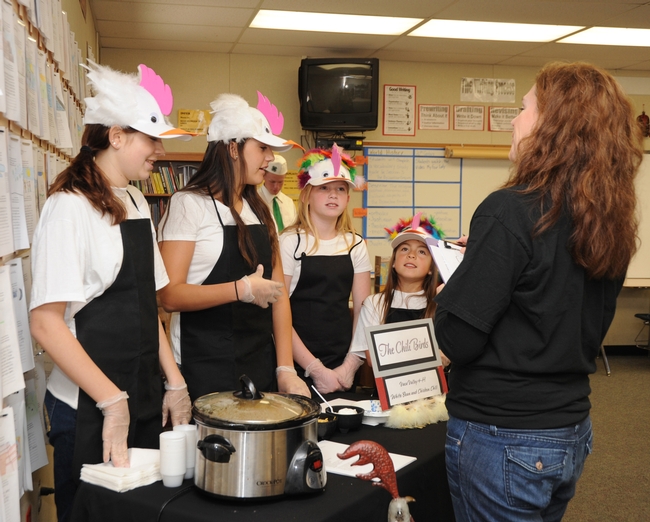
Winning team, the Chili Birds of the Vaca Valley 4-H Club, with judge Heidi Johnson. (Photo by Kathy Keatley Garvey)
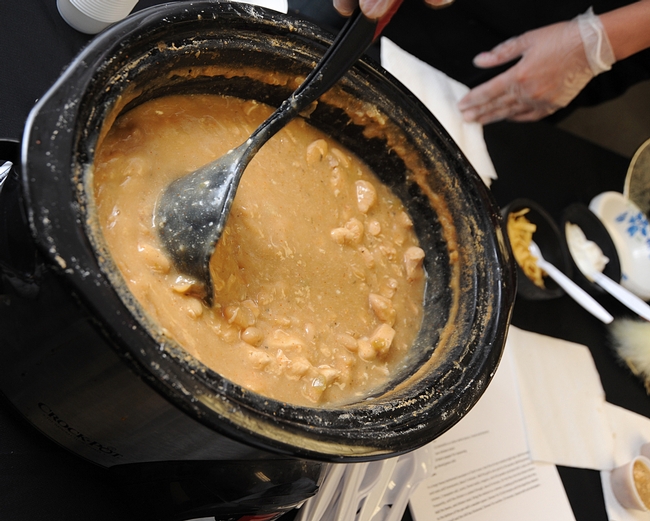
Close-up of winning dish, "White Bean and Chicken Chili." (Photo by Kathy Keatley Garvey)
Know your farmer, know your food
The 2008 Farm Bill provided more support for local and regional agriculture. In 2009, under the leadership of deputy secretary Kathleen Merrigan, the USDA launched its Know Your Farmer, Know Your Food initiative, with an eye towards doing just that. The list of initiative goals is lengthy, but include promoting, locally and regionally produced and processed foods; expanding access to affordable and fresh food; and demonstrating the explicit connections between food, agriculture, communities and the environment.
Know Your Farmer, Know Your Food is a USDA-wide effort. It is not a new department, but rather, an effort that seeks to more effectively connect existing USDA departments and work to strengthen local and regional food systems.
We know that demand for local and regional foods is strong. Per USDA statistics, the number of farmers markets has more than tripled in the past 15 years and there are now more than 7,175 around the country. The community supported agriculture (CSA) model has grown from 2 operations in 1986 to more than 4,000 today. Farm-to-school programs have experienced explosive growth, and are now found in 48 states, and total more than 2,200 (per the USDA, there were two such programs in 1996). There are “branding” efforts touting what is produced “locally” (or regionally, or statewide) in each of the 50 states.
These efforts are important: local and regional food efforts are vital to local economies, as they can often provide farmers with a higher share of the food dollar. Local jobs are supported and created in this manner, as money spent at a local business often continues to circulate within the community, creating a multiplier effect. Food dollars are good dollars.
On February 29, 2012, the USDA’s Know Your Farmer, Know Your Food initiative launched its new Know Your Farmer (KYF) Compass. The KYF Compass is a digital guide to USDA resources related to local and regional food systems. The KYF Compass organizes the USDA's work on local and regional food systems into seven thematic areas. The Compass provides tools for navigating to learn more about local and regional food systems and projects. The site enables users to secure the most up-to-date information and create interactive scenarios on a variety of topics relating to local and regional food systems, including:
- What local and regional food systems are
- Infrastructure
- Farm-to-Institution (including Farm-to-School)
- Stewardship and local food
- Local meat and poultry
- Healthy food access
- Careers in agriculture and food systems
- Case studies
- Interactive mapping tools that enable site users to locate USDA-funded local and regional food systems projects in their area (note to researchers: score!)
One of my interests is food access. The site did not fail to satisfy me in this respect. The food environment atlas tool enabled me to construct a spatial overview of the ability of specific communities to access healthy and fresh foods. In very short order, I was able to construct a rough demographic overview of how my county measured up in terms of residents’ access to grocery stores, the prevalence (and growth) of fast food restaurants, etc. This information could then be compared against other communities (or in my case, adjacent counties). This tool, along with other USDA food access tools, will prove invaluable to site users (including social science researchers). The USDA’s Economic Research Service produces some of the most cutting-edge and valuable research in this area; the site makes this information even more accessible.
The site also provides ways consumers can more directly connect with producers, a key part of building and sustaining local and regional food economies.
The Compass explicitly links food and agriculture, and shows just how interconnected the food system is with the economy, the health of communities, and the larger environment.
President Obama recently said, “Local food systems work for America: when we create opportunities for farmers and ranchers, our entire nation reaps the benefit.” The Know Your Farmer, Know Your Food initiative continues to grow, to improve and to support this vital sector of our nation’s food system.
A big bowl of dark leafy greens and ...
We all know that eating dark leafy greens is good for us, right? So that’s why for lunch lately I’ve been on a health kick to eat a big bowl of dark leafy greens topped with a lean protein source. I have, however, been subject to some good-natured ribbing around my office regarding my lunch selections. So I decided to research my lunch ingredients, and why I, as well as my inquisitive co-workers, already know it’s something of a power lunch, in the most nutritious of ways. First, the base of my lunch: a mix dark leafy greens (today it’s spinach, baby bok choy, and red and green chard).
The USDA describes the following general health benefits by eating your vegetables:
- Eating a diet rich in vegetables and fruits as part of an overall healthy diet may reduce risk for heart disease, including heart attack and stroke.
- Eating a diet rich in some vegetables and fruits as part of an overall healthy diet may protect against certain types of cancers.
- Diets rich in foods containing fiber, such as some vegetables and fruits, may reduce the risk of heart disease, obesity, and type 2 diabetes.
- Eating vegetables and fruits rich in potassium as part of an overall healthy diet may lower blood pressure, and may also reduce the risk of developing kidney stones and help to decrease bone loss.
- Eating foods such as vegetables that are lower in calories per cup instead of some other higher-calorie food may be useful in helping to lower calorie intake.
And specifically, dark leafy greens are nutrition-dense, with loads of vitamins (Vitamin K, C, E and B), minerals (iron, potassium, magnesium and calcium) and fiber. Additionally they contain beta-carotene, lutein and zeaxanthin, which aide in disease prevention.
Second, the toppings. I’ve left this part for the end, because those co-workers of mine thought you might not still be reading if I let you in on my super power lunch protein choice, so here it is: a can of herring.
Surprised? Yep, herring is really good (I already like herring, but I love the lemon pepper variety), and there’s no need to add dressing, just dump the whole can on your salad! Sardines, smoked oysters and tuna — all on the “Good alternative” or “Best Choice” list on the Monterey Bay Aquarium Seafood Watch — are also delicious. They’re also very convenient and relatively inexpensive, especially if you stock up when they’re on sale. Fish is a super-food of protein choices, evidenced by the USDA Dietary Guidelines for Americans 2010:
“Mean intake of seafood in the United States is approximately 3 1/2 ounces per week, and increased intake is recommended. Seafood contributes a range of nutrients, notably the omega-3 fatty acids, eicosapentaenoic acid (EPA) and docosahexaenoic acid (DHA). Moderate evidence shows that consumption of about 8 ounces per week of a variety of seafood, which provide an average consumption of 250 mg per day of EPA and DHA, is associated with reduced cardiac deaths among individuals with and without pre-existing cardiovascular disease.”
A recent USDA paper says fish consumption is especially beneficial to pregnant and lactating women: “increased maternal dietary intake of long chain omega-3 fatty acids, in particular DHA from at least two servings of seafood per week during pregnancy and lactation is associated with increased DHA levels in breast milk and improved infant health outcomes, such as visual acuity and cognitive development.” (See complete February 2012 article.) And, just as I was getting ready to submit my blog, an article entitled “Brainpower Tied to Omega-3 Levels” appeared in the NY Times. How’s that for timing!
All this is not to say that chicken breast, tofu or beans are to scoff at, but do you get your USDA-recommended two servings of fish a week? What about that recommended two servings of chicken breast? Or tofu? Even beans don’t get a mention of how many times a week you should eat them. And for this I get razzed by my co-workers. Hmmph—bon appetite!


